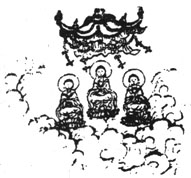From issue 110:
PRAJNA-PARAMITA AND CHINESE CH’AN
-by Bhikshuni Shih Hui Wen

The T'ien-t'ai School centers its doctrine on the Lotus Sutra. Based on
the Maha-prajna-paramita Sutra![]() and the commentary Ta Chih-Tu
Lun
and the commentary Ta Chih-Tu
Lun![]() , it
developed its meditation system during the Sui dynasty(
, it
developed its meditation system during the Sui dynasty(![]() 581-618) regarding practical
cultivation and doctrinal study as of equal importance and admitting no
difference between the rules and Ch'an. Its practice of the six paramitas
actually transcends them and therefore corresponds to the four modes of
perfecting beings. As the Ta Chih-Tu Lun states: "Again, the Buddha
spoke this Prajna-paramita Sutra because he intended to declare the
absolute mode of perfecting beings. There are four modes of perfecting
beings: first, the mode of worldly truth; second, the mode individually
adapted to each being; third, the mode of counteracting and healing; and
fourth, the absolute mode. " The Lotus Sutra is an exposition of
these four modes wherefore it embodies true emptiness as well as wonderful
existence.
581-618) regarding practical
cultivation and doctrinal study as of equal importance and admitting no
difference between the rules and Ch'an. Its practice of the six paramitas
actually transcends them and therefore corresponds to the four modes of
perfecting beings. As the Ta Chih-Tu Lun states: "Again, the Buddha
spoke this Prajna-paramita Sutra because he intended to declare the
absolute mode of perfecting beings. There are four modes of perfecting
beings: first, the mode of worldly truth; second, the mode individually
adapted to each being; third, the mode of counteracting and healing; and
fourth, the absolute mode. " The Lotus Sutra is an exposition of
these four modes wherefore it embodies true emptiness as well as wonderful
existence.
About 500 years (from the Eastern Han Dynasty(![]() ), 25-220, to the great Master
Chih-i(
), 25-220, to the great Master
Chih-i(![]() ), 538-597, of the Sui Dynasty) after the transmission of original
prajna-paramita and fundamental prajna-paramita, China developed
"Tathagata ch'an, (dhyana)." According to the Great Master Kui-feng
), 538-597, of the Sui Dynasty) after the transmission of original
prajna-paramita and fundamental prajna-paramita, China developed
"Tathagata ch'an, (dhyana)." According to the Great Master Kui-feng![]() ,
Chinese ch'an can be categorized as non Buddhist ch'an, worldling ch'an,
lessor ch'an, greater vehicle ch'an, and ultimate vehicle of Tathagata
ch'an. Because the "Mahayana Samatha Vipasyana"
,
Chinese ch'an can be categorized as non Buddhist ch'an, worldling ch'an,
lessor ch'an, greater vehicle ch'an, and ultimate vehicle of Tathagata
ch'an. Because the "Mahayana Samatha Vipasyana" ![]() of the second
T'ien-t'ai patriarch Hui-szu(
of the second
T'ien-t'ai patriarch Hui-szu(![]() ,
511-574)provided a thorough elucidation of Tathagata-garbha,
the whole meditation system of this school is also called "Tathagata
ch'an) or, due to its scriptural foundations, "parajna-paramita
ch'an."
,
511-574)provided a thorough elucidation of Tathagata-garbha,
the whole meditation system of this school is also called "Tathagata
ch'an) or, due to its scriptural foundations, "parajna-paramita
ch'an."
The six generation tradition handed down from Bodhidharma(![]() ?-528)
developed incessantly on the lines of the Lankavatara Sutra(
?-528)
developed incessantly on the lines of the Lankavatara Sutra(![]() ) and the prajna-paramita.
Only the five or seven schools respectively which split after Hui-neng,
began to neglect the aspect of "wonderful existence" though they
continued to emphasize emptiness. "The tradition of (Ch'ing-yuan
) and the prajna-paramita.
Only the five or seven schools respectively which split after Hui-neng,
began to neglect the aspect of "wonderful existence" though they
continued to emphasize emptiness. "The tradition of (Ch'ing-yuan![]() and)
Shih-t'ou
and)
Shih-t'ou ![]() which sprang from Ts'ao-hsi
which sprang from Ts'ao-hsi![]() was extraordinarily closely related
to the Niu-t'ou (
was extraordinarily closely related
to the Niu-t'ou (![]() ) branch. In the beginning, both were considered to belong
to the same brand of total negation and non dependence...It arose from a
mergence with philosophical Taoism. Fiercely rejecting knowledge and
seeing no need for activity, it became the Chinese Ch'an School which
heeded only self-benefit and paid no attention to benefitting
others." The result of this development from the Greater Vehicle to
the lessor one may well be likened to a sighted person without feet.
) branch. In the beginning, both were considered to belong
to the same brand of total negation and non dependence...It arose from a
mergence with philosophical Taoism. Fiercely rejecting knowledge and
seeing no need for activity, it became the Chinese Ch'an School which
heeded only self-benefit and paid no attention to benefitting
others." The result of this development from the Greater Vehicle to
the lessor one may well be likened to a sighted person without feet.
NOW
AVAILABLE FROM BTTS
DHARMA FLOWER SUTRA, vol. 3 contains chapter 2, Expedients. In this chapter the Buddha emerges from samadhi to praise the profundity of the Buddha's wisdom which is beyond the understanding of both the Sound Hearers and Conditioned-Enlightened Ones. He also states that Dharma Skillfully, gladdening the hearts of all.
DHARMA FLOWER SUTRA, Vol. 4 contains chapter 3, A parable. This chapter is an elaborate but simply spoken parable of children trapped in a burning house and of the devices their father uses to help them escape. It is a treasury of Buddhist doctrine elucidated through this intricate parable and the book promises to be a classical text of Buddhist Studies.
SONGS FOR AWAKENING. Songs that praise the Buddhas and Bodhisattvas, spell out the sufferings of the Saha world, and ring with truths on how to learn to transcend sorrow into bliss. A beautifully soft-bound book, each individually seal-wrapped, SONGS FOR AWAKENING is available now at Gold Mountain, 1731 15th Street, San Francisco. Ca.